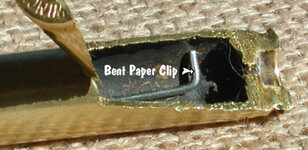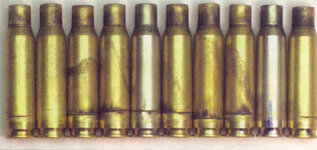rayporter
WKR
i would keep a close eye on that ammo. i have a feeling lube is not the only culprit.
Follow along with the video below to see how to install our site as a web app on your home screen.
Note: This feature may not be available in some browsers.
That’s what I was hoping to hear. My dumbass mistake.
Thanks for all the replies.

 www.reloadingallday.com
www.reloadingallday.com
This^Maybe the first round. Not after that.
Being a custom, I’d bet you have a non-SAAMI throat in the rifle giving you pressure. Call the builder let them know what’s going on. It sucks to have to hammer your bolt open in the field. That’s where you’re headed next.
the handloads are actually a few more grains and faster fps but didn’t do this but same 175g. I have every piece of brass this rifle has cycled and looked over each box. Four of the first 5 rounds today had ejector marks and the 4th was the one with the primer coming out and black marks near the ejector. They get better as I progressed and the 2nd box was fine. My son was shooting next to me with the same ammo and had no issues. I THINK - after reading the article above that my rounds were getting oil on them or I failed to remove all the oil from the chamber from the last cleaning - or both. The spring in the mag felt like it would catch and I lubricated it at the last cleaning and I think some of that oil got on the first several rounds - especially the 4th at the bottom of the mag. The first round I inserted into the chamber - it was ok. The next 3 I cycled and that 4th round was at the bottom of the mag and got the most crap/excess oil on it I suspect. Too much oil is bad, lesson learned. I do need to find more articles about bad signs on cases and what to look for. I appreciate all the feedback.This^
try a smaller grain bullet is the only other option imo.
If no oil in the chamber then the rifle has a tight chamber as gbflyer wrote and bullet ogive making contact or seated to long(whatever the proper wording is) for the chamber is the issue. Smaller grain bullet will or should be shorter and pressure signs will go away.the handloads are actually a few more grains and faster fps but didn’t do this but same 175g. I have every piece of brass this rifle has cycled and looked over each box. Four of the first 5 rounds today had ejector marks and the 4th was the one with the primer coming out and black marks near the ejector. They get better as I progressed and the 2nd box was fine. My son was shooting next to me with the same ammo and had no issues. I THINK - after reading the article above that my rounds were getting oil on them or I failed to remove all the oil from the chamber from the last cleaning - or both. The spring in the mag felt like it would catch and I lubricated it at the last cleaning and I think some of that oil got on the first several rounds - especially the 4th at the bottom of the mag. The first round I inserted into the chamber - it was ok. The next 3 I cycled and that 4th round was at the bottom of the mag and got the most crap/excess oil on it I suspect. Too much oil is bad, lesson learned. I do need to find more articles about bad signs on cases and what to look for. I appreciate all the feedback.
Good find and good read ....Technically, yeah. But without a pressure trace, just looking at the case after firing, it looks like typical overpressure.

Does lubricant or water increase pressure on handloads?
One of the most commonly asked questions and theories around hand-loaded ammunition is if leaving lubricant or getting water on cases increases pressure.The reason this speculation or theory has taken off is that commonly many individuals will shoot in geographical locations where it rains very...www.reloadingallday.com
As you look into pressures and handloading, it’s good to keep in mind what the goal is. We want pressures to produce good velocity, but with the rifle/barre/bullet/case/powder/primer combination brass needs to last a reasonable amount and extract reliably. Case will eventually fail - loaded to really high pressure they may only last a few reloads before the primer pocket expands too much or the case head separates. Loaded to extra low pressure cases last almost indefinitely. Loads that allow a case to last 10 loads is my personal goal. That provides lots of velocity, but good extraction and overall reliability.The rifle is a McWhorter 7prc with a Borden action.


The issue sounds like oil on the rounds and in the chamber.Technically, yeah. But without a pressure trace, just looking at the case after firing, it looks like typical overpressure.

Does lubricant or water increase pressure on handloads?
One of the most commonly asked questions and theories around hand-loaded ammunition is if leaving lubricant or getting water on cases increases pressure.The reason this speculation or theory has taken off is that commonly many individuals will shoot in geographical locations where it rains very...www.reloadingallday.com
